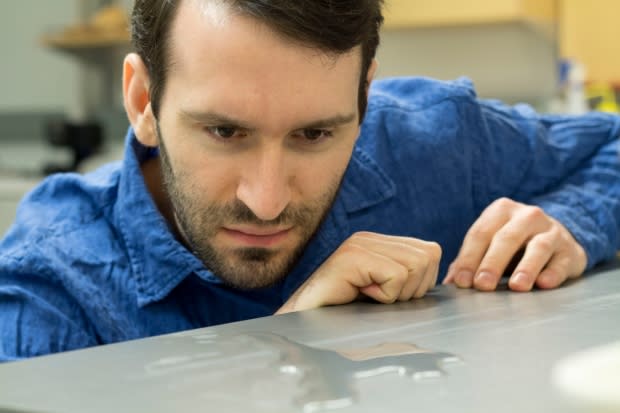New anti-ice coating makes ice cubes slip out of trays and could be used on car windshields, airplane wings

Canadian engineers have developed a new type of material that can be applied to different surfaces in order to make them almost repellent to ice.
Applied to an ice-cube tray, the coating makes the cubes slip out with almost no force at all.
Researchers hope it could one day be used to de-ice airplane wings or make scraping car windshields a breeze on those cold winter mornings.
"You can think of it like a spray paint," said Kevin Golovin, an assistant professor of engineering at the University of British Columbia's Okanagan campus.
"You don't necessarily have to spray it, but it's a surface treatment that affords these anti-icing properties."
Golovin is the lead author of a paper published this week in the prestigious journal Science that details the properties of the new material.

He says the key is its "low interfacial toughness," meaning it creates a fragile interface with ice.
One small crack in the interface propagates across the entire surface, causing the bonds between ice and the material to break away in a chain reaction.
Golovin likens it to knocking down dominoes.
"You only have to push one down, and it knocks all of them down — if you design them correctly," he said.
"The advantage of that is it doesn't really matter how many additional dominoes you have. All you have to do is knock down the first one and then they all fall down. So these anti-icing properties, basically, are useful for very large surfaces."
He said researchers are currently working on improving the durability of the material.
"If you want to get something like this on the side of an airplane, you have to make it as robust as possible," he said. "And that's sort of a whole new ball game."

As it stands, though, he said the material could likely be used for some applications already.
He suggested, for example, that it could save energy in automated ice-making machines, which currently use heat to free the ice from trays in which they are formed.
Golovins said he's "really excited in the new directions that other people take this idea."
"It's sort of a new material property. This is the first-ever publication on interfacial toughness of low-ice-adhesion surfaces," he said.
"So probably someone else across the world is going to do something amazing and push this forward in ways I hadn't even thought of yet, and that's going to be the coolest thing to see."

